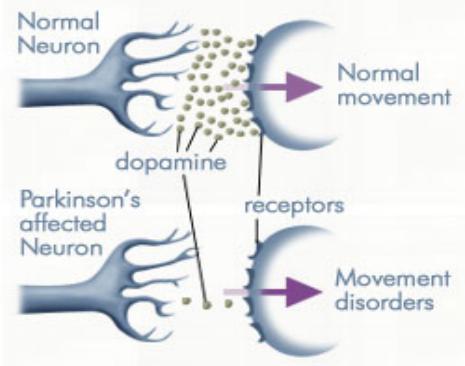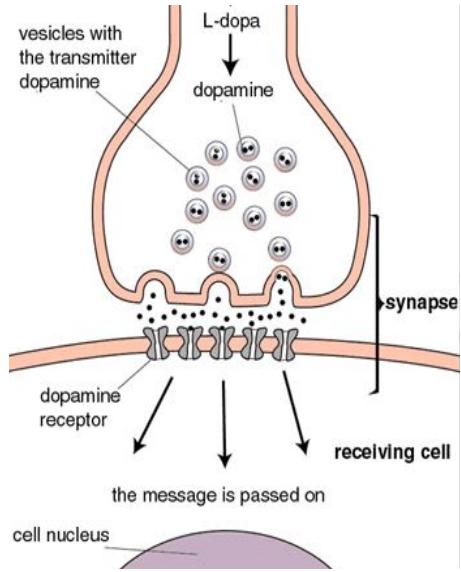
Nutrition Therapy for Parkinson’s Disease: Do’s and Don’ts
Parkinson’s disease is a gradually growing abnormality of the CNS (central nervous system). It is a chronic disease that mainly affects the portion which is associated with the movement. The main symptoms of Parkinson’s are:
- Small tremors
- Slowing of movements
- Stiffness and rigidity of body parts
- Slurred speech
- Postural instability
- Constipation
- Depression, confusion, disorientation
- Insomnia
- Excessive sweating
- Dementia
These symptoms seem related to muscles but the root cause is due to improper working of nervous system. There is no known remedy that can cure Parkinson’s Disease. But these systems can be treated by drug Levodopa and Carbidopa. Levodopa ia administered along with Carbidopa that gets absorbed in the blood stream and crosses the Blood Brain Barrier (BBB). DOPA Carboxylase converts Levodopa to dopamine that’s helps in proper signalling in Nigra.
Development of Parkinson Disease through Loss of Dopaminergic Signaling:
Parkinson’s Disease arises as a result of nerve cells called neurons gradually breaking down or dying in the brain. These nerve cells are located in the substantia nigra region of the midbrain. The substantia nigra is a part of the brain that plays a role in movement and requires the neurotransmitter dopamine, a chemical responsible for signaling connections in the brain that lead to outward changes such as movement.
In patients with Parkinson’s Disease, these dopaminergic neurons (neurons that produce dopamine and transmit dopamine signals) are destroyed. Therefore dopamine is no longer produced in this area of the brain and cannot signal to control body movements. It is estimated that 70% of neurons in the substantia nigra are destroyed at the time of first symptoms. As more neurons die, the symptoms become worse.
It is not understood how these neurons die, but Parkinson’s Disease drug therapy involves promoting an increase in dopamine levels in the brain to promote dopaminergic signaling in the substantia nigra, ultimately leading to body movements.
Mechanism of Parkinson’s Disease Drug Therapy:
The most common therapy involves levodopa (L-Dopa), which is taken in combination with carbidopa. Both drugs work together to decrease the symptoms of Parkinson’s disease. L-Dopa has been the most effective treatment for Parkinson’s.
This drug is a dopamine precursor as it is a molecule that is converted to dopamine by an enzymatic reaction once it is inside the body. L-Dopa is taken orally that gets absorbed in the blood stream, and crosses the blood-brain barrier. The blood-brain barrier (BBB) is a filter that selectively allows the passage of certain substances from the periphery into the brain and vice versa.
L-Dopa can cross the blood-brain barrier while dopamine cannot, which is why L-Dopa is given as the drug instead of dopamine. Once L-Dopa crosses the blood-brain barrier, it is converted to dopamine by an enzyme called DOPA Decarboxylase (DDC). This enzymatic reaction increases dopamine levels in the brain so signaling for movement in the substantia nigra can occur.
L-Dopa is converted to dopamine inside the neuron, where it is packaged into a vesicle. The vesicle travels to the end of the neuron and enters the synapse, where it releases dopamine. The dopamine can then bind to a receptor on the receiving cell to pass on the message. These messages consist of electrical signals that ultimately lead to muscle movement.
Nutrition Requirements for Parkinson’s Disease:
- Carbohydrates: 55-60% of the calories should come from CHO as it helps Levodopa absorption. It also increases the release of insulin and indirectly lowers the blood levels of amino acids.
- Fats: High intake of fats slows down the gastric emptying which leads to decrease the effectiveness of Sinemet for PD. 30% of calories should come from fats.
- Fibres: PD can slower the bowel movement that leads to constipation . Foods rich in fibre and fluids like Buttermilk, coconut water, vegetable soup, lemon juice, salads, fruits, etc is advised to take regularly.
- Fluid intake: Levodopa increases the risk of dehydration that can lead to confusion, weakness, balance issues, kidney failure, etc. 3-4 litres of fluids is advised with a little of salt and honey in it.
- Vitamin and mineral supplementation: PD can lead to weight loss and malnourishment, hence Vit-D, Vit- B12, potassium, calcium, magnesium helps in strengthening of bones, reduces the chances of fractures and reduce bloating and edema.
- Protein interactions: Levodopa (sinemet) is a protein building block, so it competes for absorption with other protrins. Proteins to be taken in less quantity (but high biological value protein) as proteins interferes with the absorption Levodopa. Levodopa to be taken atleast 40-60 minutes before the meals.
- Vit-B12 needs to be given in adequate amount helps in proper functioning of CNS and also strengthens the neurons and reduces the progression of PD.
- Others: Green tea, turmeric, Gingko Bioloba helps in dopamine production, protects the nerves and brain from damage.
Conclusion
A balanced nutrition is important for Parkinson’s disease as it will help in proper energy distribution to the body, maximum potential of medications and promotes dopamine production. A single diet pattern can’t treat PD. Consuming fruits and vegetables helps to keep energized and hydrated. Fibre rich foods reduces the symptoms of constipation and low blood pressure. Calcium, magnesium, vit-C, vitB12 improves the body’s nervous system. Adjusting the meal and medication timings is very important to avoid drug nutrient interactions. A balanced diet will promote overall well being.
Author
This informative article has been written by Team AbhiFit’s dietitan Sikita Soni in Dubai.
Please contact me Abhinav Malhotra to learn what I and my team AbhiFit can do for you through nutrition and personal training services. We train kids, teens, adults, elders, athletes and models in Dubai and online across the UAE and around the world. We help our clients achieve their fat loss, weight loss, muscle gain, strength gain, rehab, figure / physique transformation & healthy living goals.
Many female and male clients including kids, teens, adults and elderly people have greatly benefited from Abhinav’s strong experience as the best personal trainer and nutritionist in Dubai, UAE. You can see some of our client transformations here.
Email your Name and WhatsApp No. to info@abhifit.com if you want to receive a notification whenever we publish a new article.
Get Fit Now!


Calories in drinks Source.
About Author
Abhinav Malhotra
Abhinav Malhotra is an award-winning personal trainer, coach and sports nutritionist in Dubai, UAE. He also offers online services to clients around the world. A personal trainer par excellence, Abhi has worked with the world’s leading fitness chains, supplement brands and founded his own fitness academy in India. He has achieved successes for many clients from all backgrounds and has trained the Indian Army Rugby Team. He is the first International Kettlebell Sport athlete from India.


